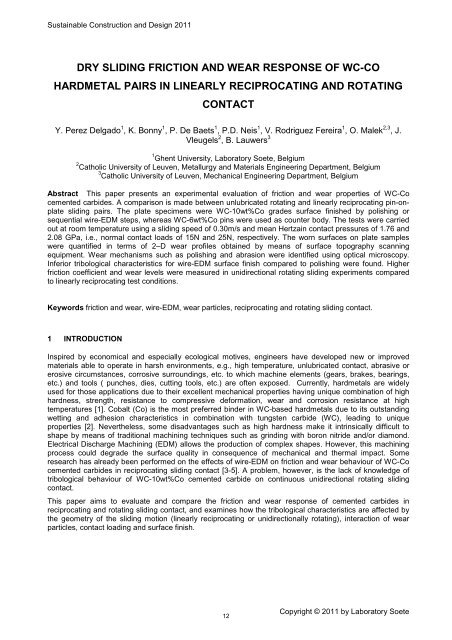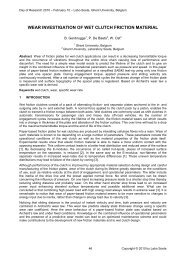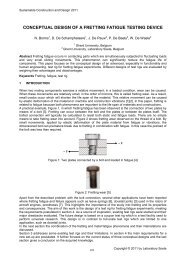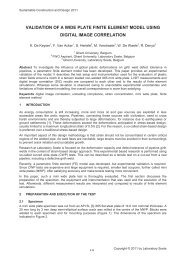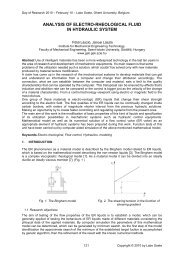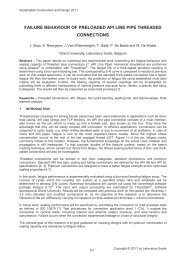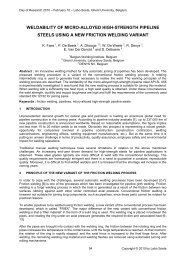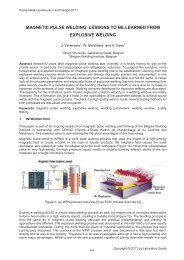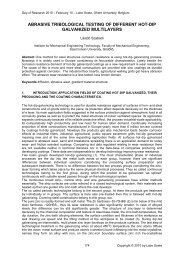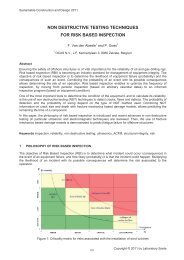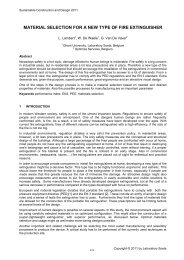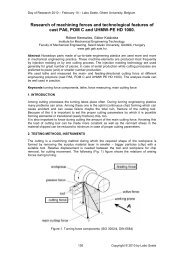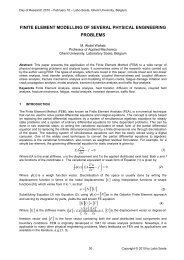Volume 2, Issue 1, 2011, Full Text - 5th International Conference on ...
Volume 2, Issue 1, 2011, Full Text - 5th International Conference on ...
Volume 2, Issue 1, 2011, Full Text - 5th International Conference on ...
Create successful ePaper yourself
Turn your PDF publications into a flip-book with our unique Google optimized e-Paper software.
Sustainable C<strong>on</strong>structi<strong>on</strong> and Design <str<strong>on</strong>g>2011</str<strong>on</strong>g><br />
DRY SLIDING FRICTION AND WEAR RESPONSE OF WC-CO<br />
HARDMETAL PAIRS IN LINEARLY RECIPROCATING AND ROTATING<br />
CONTACT<br />
Y. Perez Delgado 1 , K. B<strong>on</strong>ny 1 , P. De Baets 1 , P.D. Neis 1 , V. Rodriguez Fereira 1 , O. Malek 2,3 , J.<br />
Vleugels 2 , B. Lauwers 3<br />
1 Ghent University, Laboratory Soete, Belgium<br />
2 Catholic University of Leuven, Metallurgy and Materials Engineering Department, Belgium<br />
3 Catholic University of Leuven, Mechanical Engineering Department, Belgium<br />
Abstract This paper presents an experimental evaluati<strong>on</strong> of fricti<strong>on</strong> and wear properties of WC-Co<br />
cemented carbides. A comparis<strong>on</strong> is made between unlubricated rotating and linearly reciprocating pin-<strong>on</strong>plate<br />
sliding pairs. The plate specimens were WC-10wt%Co grades surface finished by polishing or<br />
sequential wire-EDM steps, whereas WC-6wt%Co pins were used as counter body. The tests were carried<br />
out at room temperature using a sliding speed of 0.30m/s and mean Hertzain c<strong>on</strong>tact pressures of 1.76 and<br />
2.08 GPa, i.e., normal c<strong>on</strong>tact loads of 15N and 25N, respectively. The worn surfaces <strong>on</strong> plate samples<br />
were quantified in terms of 2–D wear profiles obtained by means of surface topography scanning<br />
equipment. Wear mechanisms such as polishing and abrasi<strong>on</strong> were identified using optical microscopy.<br />
Inferior tribological characteristics for wire-EDM surface finish compared to polishing were found. Higher<br />
fricti<strong>on</strong> coefficient and wear levels were measured in unidirecti<strong>on</strong>al rotating sliding experiments compared<br />
to linearly reciprocating test c<strong>on</strong>diti<strong>on</strong>s.<br />
Keywords fricti<strong>on</strong> and wear, wire-EDM, wear particles, reciprocating and rotating sliding c<strong>on</strong>tact.<br />
1 INTRODUCTION<br />
Inspired by ec<strong>on</strong>omical and especially ecological motives, engineers have developed new or improved<br />
materials able to operate in harsh envir<strong>on</strong>ments, e.g., high temperature, unlubricated c<strong>on</strong>tact, abrasive or<br />
erosive circumstances, corrosive surroundings, etc. to which machine elements (gears, brakes, bearings,<br />
etc.) and tools ( punches, dies, cutting tools, etc.) are often exposed. Currently, hardmetals are widely<br />
used for those applicati<strong>on</strong>s due to their excellent mechanical properties having unique combinati<strong>on</strong> of high<br />
hardness, strength, resistance to compressive deformati<strong>on</strong>, wear and corrosi<strong>on</strong> resistance at high<br />
temperatures [1]. Cobalt (Co) is the most preferred binder in WC-based hardmetals due to its outstanding<br />
wetting and adhesi<strong>on</strong> characteristics in combinati<strong>on</strong> with tungsten carbide (WC), leading to unique<br />
properties [2]. Nevertheless, some disadvantages such as high hardness make it intrinsically difficult to<br />
shape by means of traditi<strong>on</strong>al machining techniques such as grinding with bor<strong>on</strong> nitride and/or diam<strong>on</strong>d.<br />
Electrical Discharge Machining (EDM) allows the producti<strong>on</strong> of complex shapes. However, this machining<br />
process could degrade the surface quality in c<strong>on</strong>sequence of mechanical and thermal impact. Some<br />
research has already been performed <strong>on</strong> the effects of wire-EDM <strong>on</strong> fricti<strong>on</strong> and wear behaviour of WC-Co<br />
cemented carbides in reciprocating sliding c<strong>on</strong>tact [3-5]. A problem, however, is the lack of knowledge of<br />
tribological behaviour of WC-10wt%Co cemented carbide <strong>on</strong> c<strong>on</strong>tinuous unidirecti<strong>on</strong>al rotating sliding<br />
c<strong>on</strong>tact.<br />
This paper aims to evaluate and compare the fricti<strong>on</strong> and wear resp<strong>on</strong>se of cemented carbides in<br />
reciprocating and rotating sliding c<strong>on</strong>tact, and examines how the tribological characteristics are affected by<br />
the geometry of the sliding moti<strong>on</strong> (linearly reciprocating or unidirecti<strong>on</strong>ally rotating), interacti<strong>on</strong> of wear<br />
particles, c<strong>on</strong>tact loading and surface finish.<br />
12<br />
Copyright © <str<strong>on</strong>g>2011</str<strong>on</strong>g> by Laboratory Soete


